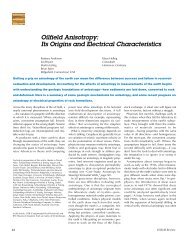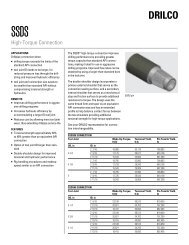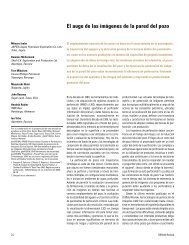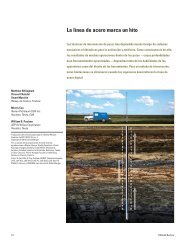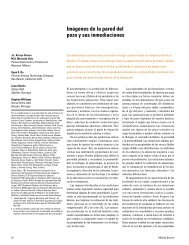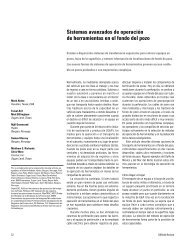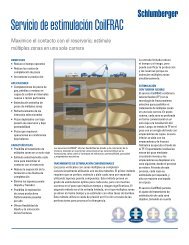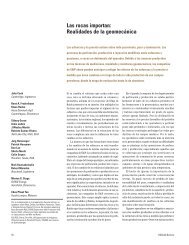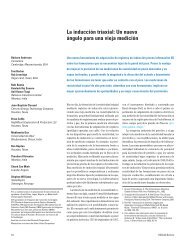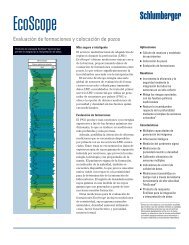Saudi Sandstone Correlations
Saudi Sandstone Correlations
Saudi Sandstone Correlations
Create successful ePaper yourself
Turn your PDF publications into a flip-book with our unique Google optimized e-Paper software.
Riyadh<br />
Ulayyah<br />
Hilwah<br />
Hawtah<br />
0 50 100<br />
Abu Jifan<br />
Dilam<br />
Raghib<br />
ST<br />
Hazmiyah<br />
Ghinah<br />
Km<br />
Nuayyim<br />
Khurais<br />
Qirdi<br />
Ain Dar<br />
Seismic line<br />
The recent discovery of large volumes<br />
of super light oil in the<br />
Unayzah sandstones in central<br />
<strong>Saudi</strong> Arabia (figure 2.1) has pleased<br />
explorationists from the <strong>Saudi</strong> Arabian<br />
Oil Company (see Middle East Well<br />
Evaluation Review, Number 11, 1991).<br />
Since these discoveries were made,<br />
<strong>Saudi</strong> Aramco's geologists and engineers<br />
have been trying to decipher the depositional<br />
history of the deeper pre-Silurian<br />
sandstones. Initially, they were thought<br />
to be equivalent to the Saq Formation<br />
and the Hanadir member of the Qasim<br />
Group (figure 2.2), which lies beneath<br />
the major oil-bearing zones to the east.<br />
There were good reasons to assume this.<br />
The new sandstone units were remarkably<br />
similar to the more familiar rocks<br />
found in the east, they occurred at similar<br />
depths, had approximately the same<br />
thickness (about 3000 ft) and lay below a<br />
major Silurian shale source rock.<br />
By the late 1980s, wireline logs<br />
recorded in the new fields of Dilam,<br />
Hawtah, Hilwah, Nuayyim and Raghib<br />
were being compared with logs in the<br />
more easterly Ghawar Field. The logs<br />
were significantly different in the deeper<br />
part of the wells, below the main oil-bearing<br />
intervals. Characteristic marker<br />
shales from the deep Saq and Qasim formations,<br />
which were obvious in the<br />
HRDH<br />
Ghawar<br />
Bahrain<br />
28 Middle East Well Evaluation Review<br />
Qatar<br />
Ghawar logs, could not be found in logs<br />
from the new wells. The absence of distinctive<br />
‘marker beds’ made it difficult to<br />
divide the new sandstone sequence into<br />
separate stratigraphic units. Lacking<br />
clear lithostratigraphic information, and<br />
without fossil evidence to help identify<br />
and date the rock layers, geologists faced<br />
a tricky correlation.<br />
Surface seismic surveys taken across<br />
the central region did not make the picture<br />
any clearer. The resolution of the<br />
deep seismic data was poor in the<br />
deeper parts of the basin, partly due to<br />
the overlying Khuff carbonate layer<br />
which absorbed much of the seismic<br />
energy. A conventional wireline log correlation<br />
between wells was attempted<br />
but this did not help to identify the units.<br />
Though the wells had been extensively<br />
cored it was impossible to produce a reliable<br />
correlation of the sandstones<br />
between wells. Age dating of fossils<br />
which were found in minor shales within<br />
the sandstones indicated that the<br />
sequence may have been younger than<br />
the familiar Saq Formation with which a<br />
correlation was being sought, but in the<br />
light of the overwhelming lithostratigraphic<br />
similarity of the units, this scenario<br />
was considered very unlikely.<br />
Fig. 2.1: Location map<br />
of the area of interest in<br />
central <strong>Saudi</strong> Arabia.



